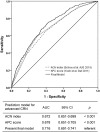A prediction model for advanced colorectal neoplasia in an asymptomatic screening population
- PMID: 28841657
- PMCID: PMC5571924
- DOI: 10.1371/journal.pone.0181040
A prediction model for advanced colorectal neoplasia in an asymptomatic screening population
Abstract
Background: An electronic medical record (EMR) database of a large unselected population who received screening colonoscopies may minimize sampling error and represent real-world estimates of risk for screening target lesions of advanced colorectal neoplasia (CRN). Our aim was to develop and validate a prediction model for assessing the probability of advanced CRN using a clinical data warehouse.
Methods: A total of 49,450 screenees underwent their first colonoscopy as part of a health check-up from 2002 to 2012 at Samsung Medical Center, and the dataset was constructed by means of natural language processing from the computerized EMR system. The screenees were randomized into training and validation sets. The prediction model was developed using logistic regression. The model performance was validated and compared with existing models using area under receiver operating curve (AUC) analysis.
Results: In the training set, age, gender, smoking duration, drinking frequency, and aspirin use were identified as independent predictors for advanced CRN (adjusted P < .01). The developed model had good discrimination (AUC = 0.726) and was internally validated (AUC = 0.713). The high-risk group had a 3.7-fold increased risk of advanced CRN compared to the low-risk group (1.1% vs. 4.0%, P < .001). The discrimination performance of the present model for high-risk patients with advanced CRN was better than that of the Asia-Pacific Colorectal Screening score (AUC = 0.678, P < .001) and Schroy's CAN index (AUC = 0.672, P < .001).
Conclusion: The present 5-item risk model can be calculated readily using a simple questionnaire and can identify the low- and high-risk groups of advanced CRN at the first screening colonoscopy. This model may increase colorectal cancer risk awareness and assist healthcare providers in encouraging the high-risk group to undergo a colonoscopy.
Conflict of interest statement
Figures







Similar articles
-
A Risk Prediction Index for Advanced Colorectal Neoplasia at Screening Colonoscopy.Am J Gastroenterol. 2015 Jul;110(7):1062-71. doi: 10.1038/ajg.2015.146. Epub 2015 May 26. Am J Gastroenterol. 2015. PMID: 26010311 Free PMC article.
-
The Asia-Pacific Colorectal Screening score: a validated tool that stratifies risk for colorectal advanced neoplasia in asymptomatic Asian subjects.Gut. 2011 Sep;60(9):1236-41. doi: 10.1136/gut.2010.221168. Epub 2011 Mar 14. Gut. 2011. PMID: 21402615
-
A modified colorectal screening score for prediction of advanced neoplasia: A prospective study of 5744 subjects.J Gastroenterol Hepatol. 2018 Jan;33(1):187-194. doi: 10.1111/jgh.13835. J Gastroenterol Hepatol. 2018. PMID: 28561279
-
Development and validation of a risk stratification-based screening model for predicting colorectal advanced neoplasia in Korea.J Clin Gastroenterol. 2015 Jan;49(1):41-9. doi: 10.1097/MCG.0000000000000102. J Clin Gastroenterol. 2015. PMID: 24583751
-
Orthopedic Coordinated Registry Network (Ortho-CRN): advanced infrastructure for real-world evidence generation.BMJ Surg Interv Health Technol. 2022 Nov 11;4(Suppl 1):e000073. doi: 10.1136/bmjsit-2020-000073. eCollection 2022. BMJ Surg Interv Health Technol. 2022. PMID: 36393890 Free PMC article. Review. No abstract available.
Cited by
-
Deep learning approach to detection of colonoscopic information from unstructured reports.BMC Med Inform Decis Mak. 2023 Feb 7;23(1):28. doi: 10.1186/s12911-023-02121-7. BMC Med Inform Decis Mak. 2023. PMID: 36750932 Free PMC article.
-
Research and Application of Artificial Intelligence Based on Electronic Health Records of Patients With Cancer: Systematic Review.JMIR Med Inform. 2022 Apr 20;10(4):e33799. doi: 10.2196/33799. JMIR Med Inform. 2022. PMID: 35442195 Free PMC article. Review.
-
Colorectal Cancer Risk Assessment and Precision Approaches to Screening: Brave New World or Worlds Apart?Gastroenterology. 2023 Apr;164(5):812-827. doi: 10.1053/j.gastro.2023.02.021. Epub 2023 Feb 24. Gastroenterology. 2023. PMID: 36841490 Free PMC article. Review.
-
A deep learning and natural language processing-based system for automatic identification and surveillance of high-risk patients undergoing upper endoscopy: A multicenter study.EClinicalMedicine. 2022 Oct 31;53:101704. doi: 10.1016/j.eclinm.2022.101704. eCollection 2022 Nov. EClinicalMedicine. 2022. PMID: 36467456 Free PMC article.
-
Risk prediction rule for advanced neoplasia on screening colonoscopy for average-risk individuals.World J Gastroenterol. 2020 Oct 7;26(37):5705-5717. doi: 10.3748/wjg.v26.i37.5705. World J Gastroenterol. 2020. PMID: 33088163 Free PMC article.
References
-
- Ferlay J, Soerjomataram I, Dikshit R, Eser S, Mathers C, Rebelo M, et al. Cancer incidence and mortality worldwide: sources, methods and major patterns in GLOBOCAN 2012. International journal of cancer Journal international du cancer. 2015. March 1;136(5):E359–86. doi: 10.1002/ijc.29210 . - DOI - PubMed
-
- Lee BI, Hong SP, Kim SE, Kim SH, Kim HS, Hong SN, et al. Korean guidelines for colorectal cancer screening and polyp detection. The Korean journal of gastroenterology. 2012. February;59(2):65–84. . - PubMed
-
- Khalid-de Bakker C, Jonkers D, Smits K, Mesters I, Masclee A, Stockbrugger R. Participation in colorectal cancer screening trials after first-time invitation: a systematic review. Endoscopy. 2011. December;43(12):1059–86. doi: 10.1055/s-0031-1291430 . - DOI - PubMed
-
- Kaminski MF, Polkowski M, Kraszewska E, Rupinski M, Butruk E, Regula J. A score to estimate the likelihood of detecting advanced colorectal neoplasia at colonoscopy. Gut. 2014. July;63(7):1112–9. doi: 10.1136/gutjnl-2013-304965 . - DOI - PMC - PubMed
-
- Shin A, Joo J, Yang HR, Bak J, Park Y, Kim J, et al. Risk prediction model for colorectal cancer: National Health Insurance Corporation study, Korea. PloS one. 2014;9(2):e88079 doi: 10.1371/journal.pone.0088079 . - DOI - PMC - PubMed
Publication types
MeSH terms
LinkOut - more resources
Full Text Sources
Other Literature Sources
Medical
Miscellaneous

